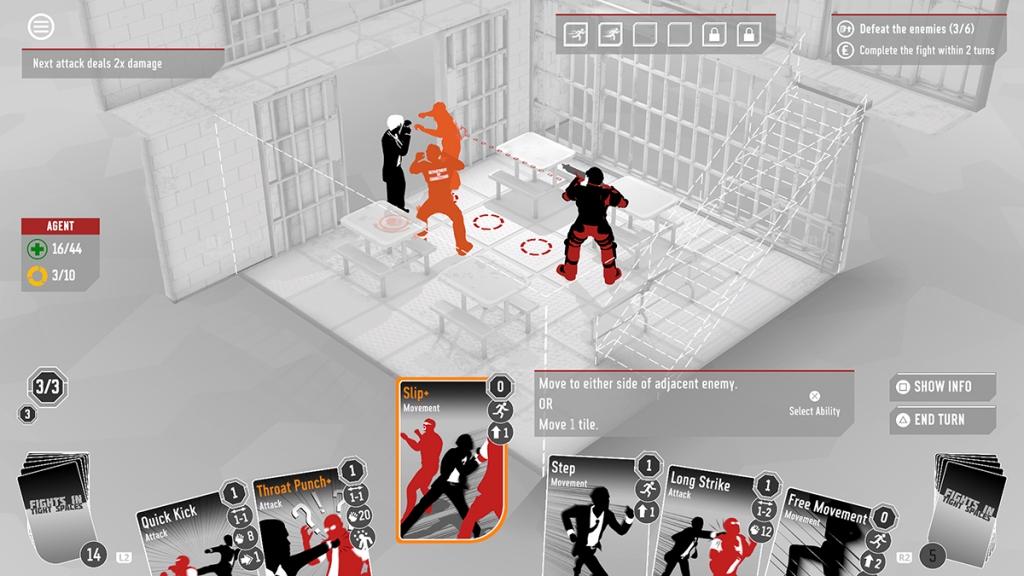The calls for a John Wick video game are often met with the rebuttal that John Wick Hex exists. Many would probably imagine a John Wick video game would look like a mix of Max Payne and Sifu, and John Wick Hex is so, so far from that since it is a strategy game. It’s a novel concept that gets players to slow down and think like the protagonist, but it was pretty terrible, which often detracts from how competent the core idea is. Fights in Tight Spaces is that idea realized, and it’s what a tactical John Wick game should be.
Fights in Tight Spaces is a roguelite deck builder where actions are represented as cards. There are obviously straightforward attacks, but there are also abilities like countering, jump kicking, wall smashing, throwing, pushing, side kicking, blocking, and more. It’s all dictated by an energy system and can add to a combo meter, which certain cards take advantage of for huge damage. The combo meter depletes if players move, so being able to string attacks together while staying put becomes yet another aspect to keep in mind. It’s sometimes risky to stay put, but it can pay off with devastating attacks that can put even the strongest foes in a coma.

Taking advantage of each card’s various properties and working within their limitations is key to survival since it’s all about positioning and making the most out of the current hand. There are a lot of variables to think about, too, like the environment and unique enemy types that make thoughtful play a requirement. Manipulating foes to hit each other, kicking a guard over a rail for instant kill, using special cards to get around an enemy’s block, throwing a goon into another for extra damage, and deftly using every energy point to outmaneuver a death trap are just some of the satisfying stunts players can pull off. There’s always some way to manipulate its interlocking systems because the mechanics are so open.
Fights in Tight Spaces gets players to feel like an acrobatic martial artist through an unexpected expected genre in a way that was only slightly hinted at with John Wick Hex. Hex was horribly balanced and often required a level of perfection its flimsy mechanics just couldn’t support; deaths were frequent and unfair. This fragility made the Baba Yaga feel more like a Baby Yaga and failed to accurately gamify one the most recognizable modern film franchises.
Pulling off combos and barely scraping by in Fights in Tight Spaces is thrilling because the tools are more open, and that’s not only crucial for roguelites, but also for the fantasy of being an action star. Great action scenes in films have the protagonist overcoming insurmountable odds through wit and brawn, and knowing how and when to play each card in Fights in Tight Spaces evokes that feeling, but in a different context. Fights in Tight Spaces even has multiple difficulty options that make mistakes more or less punishing, which opens up that action movie star fantasy to even more players.

It’s ironic that Bithell Games, the studio behind John Wick Hex, helped developer Fights in Tight Spaces. According to James Parker, founder of Ground Shatter Games, Bithell provided a “huge amount of expertise, knowledge, and feedback” that enabled the team to “take the game up a level in terms of quality.” Given this crossover, it’s possible Hex’s failings helped make Fights in Tight Spaces a more well-realized version of strategic action. Regardless, Fights in Tight Spaces shows that a John Wick-esque video game doesn’t need to be an expensive shooter, but can instead be expressed differently through a card-based strategy game that cleverly reframes and recontextualizes the ass-kicking action.
Disclaimer: This Fights in Tight Spaces feature is based on a PS4 copy provided by the publisher. Played on version 1.02.








